
Garden skullduggery... and the art of illusion
Creating illusions in a garden is nothing new. It was all the rage in the 17th-century when landed gentry used it to make their impressive country piles look that little bit more spectacular. They utilised a range of design tricks that deceived the eye – making a vista seem more extensive and an entrance grander than it really was.
Why use garden illusions?
- Small gardens seem larger
- Open spaces appear more intimate
- They can draw the eye to an attractive view
- They can be used to hide eyesores
- They add intrigue and humour
How do they work?
Every view has its natural lines of perspective and a vanishing point in the far distance. Manipulating these lines of perspective allows designers to change the way we perceive things without us knowing it. The same trick can be achieved using texture, with large leaved plants looking closer than they really are and small-leaved ones appearing more distant. Colours have even more power over our psyche, actually altering the mood or atmosphere of a garden. Impact colours, such as red and orange, will seem closer than they really are, too, whereas cooler, misty shades, such as blue and grey, will fade into the distance. You can use many of these design tricks in your own garden to make it seem larger or smaller, wider or more intimate. You can even make the end of the garden appear to continue beyond the boundary.
How do you do it?
First look at your garden and try to work out what makes you look at the things you do. Pass your eye along borders and see where your gaze unperceptively pauses a little longer – a colourful flower, perhaps or the distinct outline of a garden seat? These are the magnets that pull the casual viewer’s attention into the garden. So if it is a pile of old pots or the washing line in your garden that catch the eye, you need to work on your design.
Paths of illusion
Garden paths are often straight, running from the back door to utility areas at the bottom of the garden, or to the front gate. If the path is flat and straight with parallel edges it will make the plot seem smaller than it really is, concentrating the gaze on the end boundary. A simple curving path will instantly change the perspective and if the paving changes in size as you move away from the house (large slabs close to, smaller ones as you walk away) it will amplify the effect. Even then your eye will be directed to the boundary, in order to prevent this you need a garden exclamation mark, such as a tree, arch or statue which will grab the attention part-way down the garden.
Disappearing boundaries
Disguising the boundaries of a garden is another design trick to make a garden seem larger than it really is. The eye is fooled into thinking that the garden extends beyond the boundary fence. This can be achieved by blurring the edges of the garden with plants – a particularly effective technique in courtyard gardens where bare expanses of wall can be quite claustrophobic. Better still, be a design thief and incorporate a particularly attractive view or specimen tree or climber in your neighbour’s garden as part of the vista and the casual visitor will assume it all to be yours.
Smoke and mirrors
On a smaller scale you can introduce illusions to particular corners of the garden that need a facelift – an ugly wall or boring hedge can be transformed with perspective trellis or a simple mirror. The trellis is specially designed to create the illusion of depth and with a mirror added to the central ‘window’, it instantly creates the sense of another part of the garden beyond. Mirrors work particularly well in shady corners where they introduce much needed light. An arched mirror on a wall angled to catch an attractive vista and surrounded by climbers could look like an entrance to another garden ‘room’, while a circular mirror in the floor, angled to reflect the sky, can appear like a crystal-clear pool.
